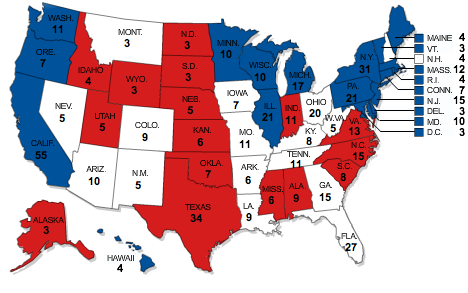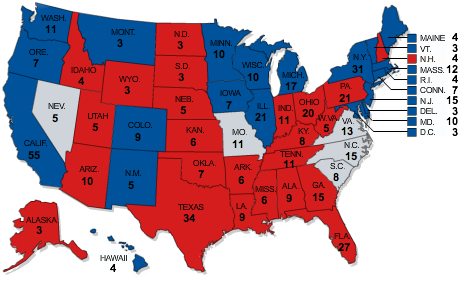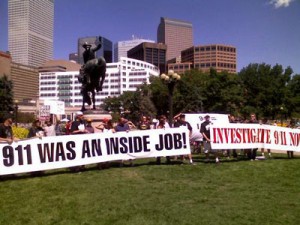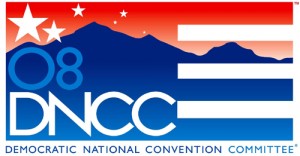Election analysis is completely speculative; no matter how many times someone says “past data suggests this will be the case,” the opposite seems to happen. If the Democratic primary was any indication, results rarely match expectations.
That being said, I want to take a look at today’s electoral map, and how it might look in five months, come November. I was playing around on USA Today’s electoral vote analyzer and came (rather accidentally) to a pretty neat discovery.
Let’s throw up our default map, which is colored in based on who won the past four presidential elections. States that did not have a consistent winner all four elections start off, naturally, as toss-ups.

Now, let’s make some assumptions. I’m first going to assume that the “Hillbilly” coalition will vote for McCain. This assumption is not difficult to make; even based on the Democratic primary between Obama and Hillary Clinton, it is pretty clear that a lot of people are just not going to vote for a black man named Barack Hussein Obama. Unfortunate, yes. But not something that is going to change between now and November. In addition to Appalachia, I’m also going to assume that the solid South will go for McCain. New Hampshire, given McCain’s popularity there, will probably go to him.
Now, I’m going to make an incredibly ridiculous assumption; one that will probably not be the case in November, but one that is worth considering. Florida, Ohio and Pennsylvania will go for McCain. Ohio and Pennsylvania definitely seem plausible; Obama performed poorly there against an opponent who was already declared politically dead by the time the elections rolled around. He lost by ten point margins in both states. Ohio and Pennsylvania both comprise a large portion of northern Appalachia; a region that is predictably (and drastically) antithetical to Obama’s candidacy. Florida is definitely a toss-up, and can go either way. But if McCain can mobilize the Jewish vote, and get independents on his side, this is definitely winnable. I foresee McCain spending a lot of time in Florida, and it will probably pay off.
At this point, the map seems to be filling in nicely for McCain.

Now, let’s make some more extrapolations. In the Southwest, we are going to see a very different map come November. Obama has clearly shown that he can attract upper middle class, educated, Western independents and Republicans, and the brand of sophisticated voter that one finds roaming under the open sky of Montana. We can safely assume that Colorado will go for Obama. The DNC isn’t throwing a 50,000 person party in Denver to see that state walk out the door. Obama is popular in Colorado; he already has a strong field organization and he has shown that he can win that state. For the same reason, Iowa should go for Obama. He built a compelling field operation there in 2007 and the Iowans seem to really like him.
For the reasons above, we can safely assume that Obama will win Montana. Aside from his normal constituency, in Montana Obama is strongly supported by Native American populations that make up a bulk of the Democratic demographic. Finally, we can give New Mexico to Obama. Richardson will be influential in bringing this state to the Democrats, and it is unlikely that Hispanics, a reliable Democratic voting bloc, will break for the Republicans because their initial candidate, Clinton, lost. Of course, Arizona goes to the Senator from Arizona.
If you are doing the math, you probably have realized that at this point McCain is clearly the victor, having racked up 271 electoral votes–one more than needed to win the presidency. Not so fast. We quickly realize that three states showed overwhelming support for Obama during the primaries and should not be ignored: Virginia, North Carolina, and South Carolina. So we designate those states as toss-ups.

Now we’ve got an interesting situation on our hands. The states that remain–Nevada, South Carolina, North Carolina and Virginia–seem like odd battlegrounds. The latter three voted republican in the last four presidential elections. Nevada voted for Clinton twice and Bush twice. However, it is looking like Nevada will vote for McCain in 2008. Union voters will probably back Obama, but rural Nevada is looking Republican, and the state where one of this season’s first push polls was distributed is not looking like its going to undo its defeat of Obama earlier this year. Perhaps, but to be safe we put Nevada in the McCain column. For the same reason, South Carolina looks like it’s going to have to go for McCain. South Carolina is more “deep” South than our other toss-ups, and despite Obama’s sure-to-be-mobilized black support there, the much larger white population is not likely to put him over the top. Again, Obama might win South Carolina, but to be safe we put it in McCain’s column.
Now we stand at Obama with 251 electoral votes, and McCain with 248. Here is our map:

Wow! Now we have three new battleground states, and it looks like we can’t predict past here. Missouri is the bellwether, of course, and neither McCain nor Obama can be predicted to win there. For one, both candidates won ties to win the state in their respective primaries; McCain won a three-way tie with Romney and Huckabee, and Obama won a tie with Clinton. Their performances were neither impressive nor decisive. Missouri could prove to disappoint analysts this year, as it doesn’t look like it will give much leeway to either campaign.
Virginia and North Carolina, of course, have been put in play by Obama’s terrific showing in both states. Thanks to this grueling primary process, he now has a field operation in all “57” states, and they’re all in full swing. It is no stretch of the imagination to see Obama winning Virginia, especially considering that he is tied with McCain in the current polls.
Mathematically, Obama or McCain need to win two out of the remaining three toss-ups to become President. That is given a scenario based heavily on the assumption that Obama will lose the traditional toss-ups, Florida, Ohio and Pennsylvania. If Obama can win one of these three, he will most surely win the election.
 At one point, a man in the audience jumped to his feet and demanded that Hayden or McDermott speak to the fact that “McCain is a war criminal and he should be tried as such,” and protested something else incoherently; he was cheered by many in the audience but neither speaker directly responded to his questions (although Hayden knew him by name).
At one point, a man in the audience jumped to his feet and demanded that Hayden or McDermott speak to the fact that “McCain is a war criminal and he should be tried as such,” and protested something else incoherently; he was cheered by many in the audience but neither speaker directly responded to his questions (although Hayden knew him by name). I suspected that these same people would be protesting later that night at the convention.
I suspected that these same people would be protesting later that night at the convention.




 Plus, he says “The political environment, probably one of the worst in our party’s history…” I know this is what has been echoed on the blogs and on the news for months, but its not something a campaign manager says. You don’t maintain a positive outlook on things by saying that your chance of winning is horrible.
Plus, he says “The political environment, probably one of the worst in our party’s history…” I know this is what has been echoed on the blogs and on the news for months, but its not something a campaign manager says. You don’t maintain a positive outlook on things by saying that your chance of winning is horrible.